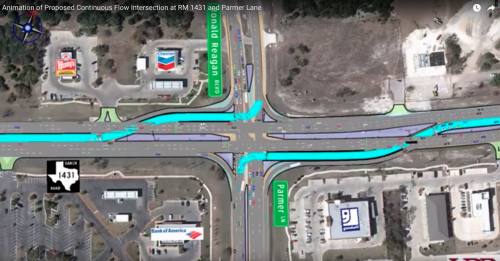
Nearly three years since the completion of a complex intersection in east Cedar Park, traffic congestion has eased, and serious, injury-causing accidents have dropped, according to state data and public officials.
However, the total number of accidents in the area of the intersection has increased.
The continuous-flow intersection, or CFI, was constructed to improve east-west traffic flow on Whitestone Boulevard/RM 1431—which connects Cedar Park with North Round Rock—and address the heavy amount of left-turn traffic onto Ronald Reagan Boulevard/West Parmer Lane.
Construction lasted from August 2014 to August 2016.
According to Texas Department of Transportation data, in 2013—the first full year before CFI construction began—there were nine reported crashes in the area of the intersection. In 2017—the first full year since construction was completed—there were 25 reported crashes in the area of the intersection.
While increased traffic volume in the intersection may have helped contribute to the increase in accidents from 2013 to 2017, TxDOT spokesperson Brad Wheelis pointed out that CFIs reduce serious accidents due to the elimination of turning across oncoming traffic.
“These are safer, faster intersections,” Wheelis said.
In 2013, there were four injury crashes, according to TxDOT. In 2017, there was one.
At most intersections, vehicles make left turns from the middle of the road, and across lanes of oncoming traffic. CFIs shift left-turning vehicles to the outer lanes to the left which allows oncoming through traffic to continue through the intersection during a left-turn cycle. Through-traffic proceeds as if it were a typical intersection. Once the left turn is made, vehicles return to the right side of the road.
According to TxDOT, CFIs and the similar diverging diamond intersections, or DDIs, also save money. CFIs and DDIs do not require the construction of overpasses or underpasses.
The CFI in Cedar Park cost $22 million. Although the city was responsible for upfront funding, TxDOT began reimbursing the city for 80 percent of the cost through annual payments that began in 2017, Wheelis said.
According to Community Impact Newspaper reports, the original cost estimate in 2012 was $17 million.
To address higher-than-expected construction costs, Williamson County ended up contributing $1.15 million as well, according to TxDOT spokesperson Chris Bishop, and TxDOT paid $1.7 million in administrative costs and $100,000 for sidewalks.
Continuous-flow intersections, as well as DDIs, are relatively new to highway engineering, with the first DDI being built in the U.S. in 2009, according to TxDOT. There will be more to come, Wheelis said.
In 2016, a DDI opened at the I-35 intersection with RM 1431/University Boulevard in Round Rock. TxDOT just broke ground on a DDI at Parmer Lane and I-35 in North Austin on July 24.





